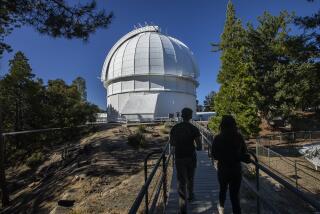It’s Been Cosmic From the Start : Science: 100 years later, Caltech still buzzes with the palpable excitement of surprise and discovery.
- Share via
When Willy Fowler arrived at Caltech as a young graduate student in the fall of 1931, the first thing he saw was America’s most famous physicist, Robert A. Millikan, arguing with Albert Einstein on the steps of Throop Hall, the old administration building. “This,” Fowler said to himself, “is the place for me.”
It was. Millikan and Einstein may have been arguing about the birth of cosmic rays, or the expansion of the universe or--more than likely--about Einstein’s stipend for his annual visit to the Pasadena school. But at the same time, elsewhere on campus, Thomas Hunt Morgan and his fruit-fly gang were laying the groundwork for modern genetics, Charles Richter was searching for a scale to measure earthquakes, and Linus Pauling was figuring out the chemical bond. Years later, Fowler would win his own Nobel Prize for helping to explain how the sun works.
In 1991, the California Institute of Technology will celebrate its 100th birthday. It is today, as it was the day Fowler arrived, an exquisite gem of American higher education. Whatever else is wrong with American education, the United States is arguably the world leader in graduate science education, with every nation in the world sending its best and brightest here to be trained. Caltech stands at the pinnacle of that achievement. And graduate students aren’t the only ones who benefit. With 800 Ph.D.s on its faculty, 825 undergraduates and 1,050 graduate students, Caltech has developed a system of intensive scientific apprenticeship unsurpassed anywhere.
How did it come to be? The answer has a lot to do with the vision and energy of a handful of men who had the scientific credentials to impress their peers and the street smarts to find needed funds.
The year 1891 saw the founding of a thoroughly undistinguished little college in Pasadena by a wealthy former abolitionist named Amos Throop. Providentially, Pasadena lay at the foot of Mt. Wilson, the spot that astronomer George Ellery Hale decided was the best in all America to build his new telescope.
Hale joined the board of trustees of the struggling school later and enticed Arthur Amos Noyes, former president of the Massachusetts Institute of Technology and the nation’s leading physical chemist, and the renowned Millikan to join him in Pasadena. The three spent World War I in Washington, serving the nation but also building a superb network of contacts that would later serve their school well. In 1920, Throop became the California Institute of Technology.
Millikan, who served as the school’s president between the world wars, was fiercely opposed to government funding of research. He managed to extract from private-sector sources the money he needed to nurse the school through the Depression. He could even afford to show a certain generosity for his faculty: Carl Anderson, a young assistant professor, was promoted to associate professor almost immediately after winning the Nobel Prize for discovering antimatter, in 1932.
World War II brought profound change in the way America conducted science. Shortly after the war, Lee DuBridge, head of MIT’s wartime radar project, became Caltech’s new president, and Robert Bacher, who personally assembled the first atomic bomb, became head of the physics division and later the institute’s first provost. Extraordinary new talent was brought in, including Richard Feynman, the enfant terrible of the Manhattan Project. Millikan still railed against the dangers of government funding, but his day was over. Research funds gushed through a conduit that led directly to Washington. A station for conducting wartime rocket experiments, banned from campus because of the obvious danger, grew into the Jet Propulsion Laboratory, today the world leader in deep-space exploration.
The Caltech of today probably isn’t exactly what Hale, Noyes and Millikan had in mind. For one thing, women figure prominently among its very best faculty and students. For another, the lonely investigator poring over handcrafted brass instruments has been replaced by the high-flying entrepreneurial teams and gleaming high technology of today’s science. But in the laboratories, the lights still burn late at night, and the classrooms and seminars still buzz with the palpable excitement of surprise and discovery. I think, for all the change, Robert Millikan would be proud of us. I know Willy Fowler is.






